- Quick Read
- Deep Read ( 11 Min. )

Why is Christian Science in our name?
Our name is about honesty. The Monitor is owned by The Christian Science Church, and we’ve always been transparent about that.
The Church publishes the Monitor because it sees good journalism as vital to progress in the world. Since 1908, we’ve aimed “to injure no man, but to bless all mankind,” as our founder, Mary Baker Eddy, put it.
Here, you’ll find award-winning journalism not driven by commercial influences – a news organization that takes seriously its mission to uplift the world by seeking solutions and finding reasons for credible hope.
Explore values journalism About usIn Today’s Issue
- Notes from a war: Resilience and anguish in a Ukraine under siege
- ‘Like a Kafka novel’: Witnessing China’s zero-COVID policy
- Images from Ukraine resonate on visit to ‘living ruin’ in Spain
- In this Mississippi city, public art points a way forward
- Putting conflict in context: A reading list for Ukraine
Monitor Daily Podcast
- Follow us:
- Apple Podcasts
- Spotify
- RSS Feed
- Download
TODAY’S INTRO
When silence says everything
War is generally a noisy affair, sometimes deafeningly so. But one of contributor Martin Kuz’s most enduring memories from Ukraine is the sound of silence.
He was on a train packed with women and children fleeing an assault on Kyiv, the capital. They had left behind their homes, their menfolk, and their lives as they rattled through the night into exile. They were numb with disbelief.
“As I listened to the silence,” Martin recalls, “it seemed the most human and natural reaction to their loss. No words could capture that.”
The night drew in, and the 12-hour journey to Lviv stretched out. Martin walked through the train, picking his way through the suitcases that clogged the aisle and studying his fellow passengers, bundled up in winter clothes. He had given his sleeper berth to two mothers and their children, and “didn’t feel comfortable just sitting,” he says.
“My mind was restless and I wanted to walk around. I wanted to absorb as much as I could about the experience because I felt it was somehow essential to trying to understand how war changes everything,” he explains.
“I was focusing on what these new refugees might be trying to absorb, this cataclysm, as they confronted the awful reality,” says Martin. “Now what? How do you prepare an answer for the unknown?”
Those questions were particularly poignant for Martin. His own father fled Ukraine as a refugee after World War II, and “echoes of that experience were very strong for me,” he says. His father’s lifelong separation from his homeland proved “a wound that could never heal,” and Martin could not help wondering how his companions on the train would mend their lives.
“Through what I knew of my father’s loss, I had a level of understanding about some of what these women and children were facing,” Martin points out.
And he found himself not only sympathizing with the refugees, but admiring them too. “As jammed as the cars were, I was struck by the civility” that the passengers showed one another, “the shared compassion and humanity,” he remembers. “They were a random collection of strangers ... but they had a common denominator – they were fleeing war.”
Share this article
Link copied.

Help fund Monitor journalism for $11/ month
Already a subscriber? Login

Monitor journalism changes lives because we open that too-small box that most people think they live in. We believe news can and should expand a sense of identity and possibility beyond narrow conventional expectations.
Our work isn't possible without your support.
A deeper look
Notes from a war: Resilience and anguish in a Ukraine under siege
Amid the devastation of war, our reporter has been moved by the resilience, courage, and resolve he has encountered in Ukraine.

A hum rose from the white wooden box as Yuri Andriyovich lifted its lid to reveal a colony of bees. Workers moved in a swirl along the honeycomb they had built, forgoing the chance to escape for the routines of a captive existence.
Before war came to Yuri’s village in eastern Ukraine, he would drive 15 miles to sell his honey at the market. The trips ended in 2014 when rockets and Russian-backed militants descended on Syze, where the retired police officer and his wife had lived for more than 40 years. He and his wife refused to flee. He found a different market, even though honey sales dipped.
The devastation that Russian forces inflicted in the east – and the defiance of the region’s people – prefigured what occurred when the larger war erupted as I traveled from the Donbas to Kyiv to the western city of Lviv. My mind fixated on my late father, a Lviv native whose bond with his country held fast amid his separation from its soil during the last 70 years of his life.
I have been struck by the compassion shown by strangers, even in the scrum to escape, giving up train seats to mothers and children, helping older people up or down stairs. But I am unsurprised by the country’s unbending resolve. If I learned anything from my father, it is this: Ukraine will fight. And Ukraine will love.
Notes from a war: Resilience and anguish in a Ukraine under siege
A gentle hum rose from the white wooden box as Yuri Andriyovich lifted its lid to reveal a colony of bees. Near the top, worker bees moved in a swirl along the honeycomb they had built, forgoing the chance to escape for the routines of a captive existence.
Eight years ago, before war came to Yuri’s village in eastern Ukraine, he would drive 15 miles to Luhansk, a city of 400,000 people, to sell his honey in jars the size of footballs. The trips ended in 2014 when rockets and Russian-backed militants descended on Syze, where the retired police officer and his wife, Lydia, had lived for more than 40 years in a one-bedroom home.
The village’s dozen other residents escaped to safety. The couple stayed as separatist and Ukrainian forces battled through 2014 and deep into the next year in the southern reaches of the Donbas, the collective name for the adjacent Luhansk and Donetsk regions.
The fighting ebbed in the ensuing years but never ceased. Some 3,400 civilians died and 1.5 million people fled across a broken, battered landscape. In Syze, 2 miles from Russia, weeds grew as tall as ceilings inside empty houses split apart by shelling.
Yuri and Lydia adapted to the confines of war rather than leave the life they knew. They seldom went elsewhere and almost no one visited. The city of Luhansk fell within the territory held by separatists, so Yuri brought his honey to a nearby town still under Ukrainian control, braving a road with more holes than asphalt in his rusting Lada. Most often he returned with several jars unsold.
Still, tending to bees busied his mind, and in recent months, the work had provided respite from the reports of a possible Russian invasion. He replaced the lid on the beehive and pulled off his knit cap, running a callused hand over his bald head and then down his broad, open face. The beekeeper stood beneath a bright blue sky and the cloud of an eight-year war.

“What will happen?” he asked. “Only God knows.”
I met the Andriyovichs a week before Russian President Vladimir Putin sent troops and tanks pouring over the border Feb. 24. Syze was one of the dozens of villages and towns along the 260-mile front line that formed a jagged scar across the southern Donbas. Now much of Ukraine is the front line and the entire country has been cut open.
The devastation that Russian forces inflicted in the east – and the defiance of the region’s people – prefigured what occurred when the larger war erupted as I traveled from the Donbas to the capital of Kyiv to the western city of Lviv. In those five weeks, as the world witnessed the fierce will and quiet resilience of Ukrainians, I thought again and again of my late father. A Lviv native and World War II survivor, he possessed the same traits and the same love of country, a bond that held fast even with his separation from its soil over the last 70 years of his life.
The residents and soldiers I encountered in the Donbas reacted with stoic readiness to the buildup of 200,000 Russian troops on Ukraine’s border. Eight years of war had conditioned them. In a region where the language and religious practices of Russia prevail, they found humor in the idea that Ukrainians might greet invading forces as liberators.
“I divorced my wife because she was pro-Russian,” Sgt. Serhiy Bachinsky said with a smile.
We stood in a muddy trench near Syze, 250 miles east of his hometown of Zaporizhzhia, and even further removed from his former profession of sports academy instructor. His doughy face and genial disposition called to mind the TV comedian Andy Richter equipped with an armored vest and automatic rifle.
Sergeant Bachinsky volunteered to fight after Russian-backed separatists seized portions of the Donbas in 2014. He soon decided to make the military his career, and as a potential invasion loomed, he offered what sounded less like a prediction than a truth yet to arrive.
“Putin talks about Ukraine being part of Russia,” he said. “We are on our land and we will defend our land.” He smiled again. “If the Russians come, they will see how much we will defend it.”

I stood in ankle-deep mud in another trench about 60 miles away when I met Sgt. Sergihy Buhai two days later. We spoke under the watchful gaze of Mr. Putin, whose frowning image adorned the pillow head of a target dummy clad in flannel and perched on a defensive barrier.
The father of three children, Sergeant Buhai belonged to a unit deployed near the mining town of Zolote, and his time in uniform paralleled Sergeant Bachinsky’s. The start of his service traced to 2014, when fighting in the Donbas exposed Ukrainian forces as unorganized, undertrained, and underfunded. NATO nations responded with increased military aid and training assistance to build the army’s capacity and competence.
Sergeant Buhai insisted that the funding had bought a professional fighting force. “We are not the same army anymore,” he said, leaning against a blue and yellow Ukrainian flag nailed to a bunker wall. He appeared unmoved by the sporadic thump of incoming artillery and mortar rounds hitting wet earth in our vicinity. “This time it won’t be us who is surprised.”
I recalled his calm assurance as I rode a train to Kyiv that evening. The fitful shelling had reminded me of the discordant sounds inside a symphony hall when orchestra musicians warm up before a concert. The random noises precede a cohesive performance, and as mothers cradled infants and couples held hands in the car around me, I wondered if I had heard Russian soldiers tuning the terrible instruments of war.
An untroubled air pervaded Kyiv in the days before Feb. 24. People filled malls and cafes, health clubs and nightclubs. Families and couples walked through parks and plazas. Workers and students sat at their desks. Cars clogged streets and trains ran on time.
The common theories in the city of 3 million residents about Mr. Putin’s intentions mirrored the prognoses of Western analysts and journalists. Most assumed the invasion would never come or would focus on the Donbas and perhaps port cities on the Black Sea and Sea of Azov.
For those in the capital, the war in the east had receded toward the horizon. Their apathy derived, in part, from the passage of time and a lack of proximity. Ukraine is about the size of Texas, and the distance from Kyiv to Luhansk – more than 500 miles – is roughly that of Dallas to the border town of Brownsville. It seemed a world apart.

The invasion’s first 24 hours ruptured the illusion of remoteness. The thunder of missile strikes and a sustained artillery battle on Kyiv’s outskirts gave sound and shape to a violent new reality. The war was here.
Black smoke rose from rocket attacks as air raid sirens blared. The cafes and shops and schools closed. Lines snaked out of pharmacies, and customers emptied shelves at any grocery store that remained open. As ATMs ran dry, customer receipts collected on the ground, the confetti of the desperate.
Traffic disappeared from the streets except for the main avenue leading west out of the city and away from the country’s heaviest fighting. Many who chose to stay moved underground. They brought blankets and sleeping bags into subway tunnels and parking garages, taking refuge together from shelling and despair.
Some struggled with the decision to leave. I crossed paths with Natasha Simonova on the invasion’s second day as she walked home after buying fruit and bottled water at a corner grocery. An attorney with an architecture firm, she had pinned a blue and yellow ribbon to her bright green sweater, and she cast her presence in the city in a patriotic light. “We must be strong for Ukraine,” she said, lifting a hand to her heart. “Our country needs every one of us.”
We spoke again four days later by phone. The deepening shadows of war had darkened her outlook. She planned to depart for Lviv by train in the morning. She had lost her bearings. “Before I was a fish in water,” she said. “Now I am a fish in vodka.”
Waves of sudden refugees flowed into Kyiv’s central railway station as the Russian offensive intensified. They had stuffed suitcases and backpacks with the fragments of their abandoned lives. They surged toward any train headed west and begged conductors to let them aboard, straining to be heard above the air raid sirens.
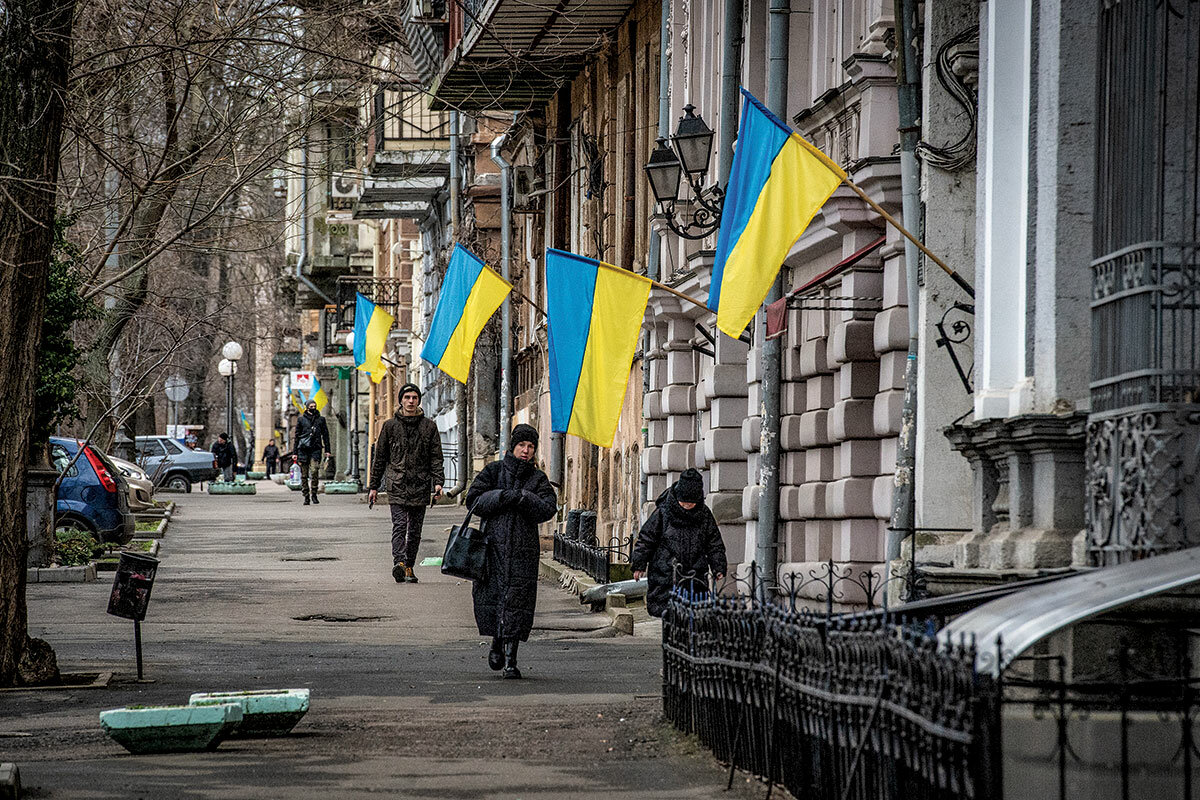
A declaration of martial law from Ukrainian President Volodymyr Zelenskyy required men ages 18 to 60 to remain in the country to fortify its military. His order turned each train’s departure into a wrenching separation. Husbands gave their wives a final kiss, and fathers hugged their children goodbye. When the trains pulled out, few knew if they would hold their loved ones again.
Strangers retained their humanity even in the scrum to escape. Three young women gave up their place in line to allow a mother with two small daughters in matching pink coats to claim seats on a car. Pairs of men and women wrapped their arms under the legs of older people and carried them up and down flights of stairs. Conductors apologized when they had to close car doors and sought to reassure those stranded that more trains would arrive.
The acts of goodwill lingered in my mind after I found a spot on a night train to Lviv. Ukraine’s military and the civilian defense force had supplied the loudest retort to Mr. Putin’s purported belief that Ukrainians would welcome his troops.
But the tacit cooperation of refugees in their moment of flight provided an equal measure of national unity. They had not trampled one another rushing to board trains as artillery shelling echoed in the distance. They recognized their shared dread and reacted with mutual compassion.
The train listed and shuddered along tracks coated with wet snow. Relieved smiles and murmured conversations passed between the wives, mothers, and grandmothers until the hour grew late. The car fell quiet. As they traveled onward in the darkness toward uncertainty, there came the sound of a woman’s hushed crying.
Katya Petrenko sat outside Lviv’s railway station with her two preteen sons and the burden of the unknown. She and two other mothers and their children had endured a 10-hour train ride after fleeing Vinnytsia. The city southwest of Kyiv absorbed heavy shelling as Russian forces targeted the headquarters of the Ukrainian air force command.
The families gathered in the wan light of a bomb shelter as the ground shook from missile strikes. Ms. Petrenko wondered if they had entered a living tomb. “You didn’t know if you were going to come out,” she said. Her husband and those of her friends remained in Vinnytsia as members of the territorial defense force. The women and their eight children intended to take another train to the Polish city of Lublin to stay with a host family.
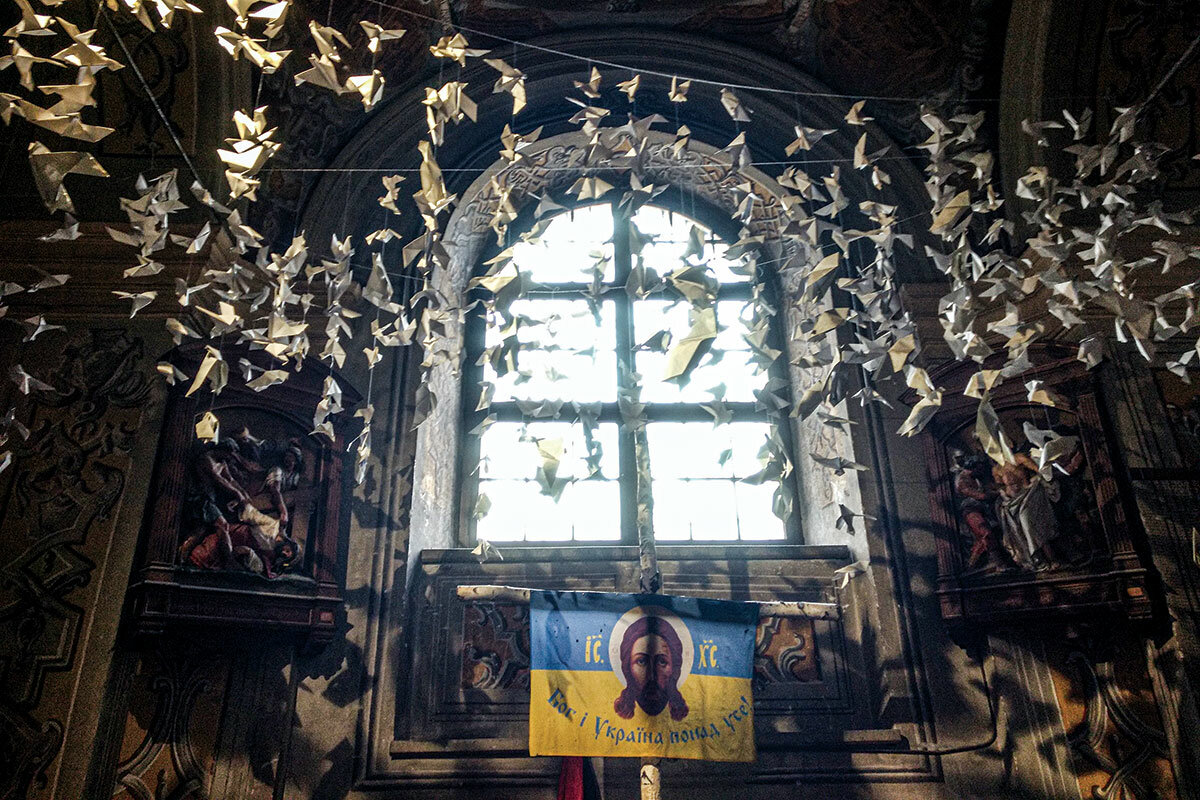
“I have no idea what we will do after that,” said Ms. Petrenko, a food technologist by training. One of her sons had brought a backpack imprinted with the slogan “Future Is Now” – a cruel taunt as war demolished the familiar contours of life. Her eyes glazed with tears. “Nobody can plan for something like this,” she said. “Nobody thinks they are going to be a refugee.”
The Russian invasion has forced more than 4 million Ukrainians out of the country, and the majority have passed through Lviv on their way to Poland, Romania, and Slovakia. Dubbed “the soul of Ukraine,” and known for its cultural sophistication and historical resistance to Russian influence, the city houses some 200,000 refugees day to day in churches, schools, and other public spaces.
Their sorrow at the prospect of losing their country and their loved ones carried echoes of my father’s experience after World War II. Eugene Kuz, born in Lviv in 1923, grew up in Josef Stalin’s Ukraine, a place of state-imposed famine and scarce hope. He was 17 in 1941 when German forces invaded his homeland, then part of the Soviet Union, and by the time the war ended four years later, he had set foot there for the last time. The Iron Curtain made returning to Ukraine too fraught with risk, and after the Soviet Union later dissolved, declining health prevented him from traveling overseas. He never again saw his parents or brothers. He never forgave Russia.
During my time in Lviv, I visited Ivan Franko Park, named after the Ukrainian poet and political activist born in the region in 1856. I found a newly installed set of wooden stairs leading underground to a bomb shelter that closed after World War II. City officials reopened the space as Russia again laid siege to Ukraine, and running my hand along its old brick walls, I wondered if my father and his family ever huddled here together, waiting for silence.
Lviv’s embrace of hundreds of thousands of strangers during the invasion has revealed the Ukrainian identity as much as the military’s unflinching resistance. A dual willingness to offer succor and take up arms embodies the national character that informs the ministry of the Rev. Roman Mentukh at Sts. Peter and Paul Garrison Church.
Built in the 17th century, and endowed with its original statuary and ceiling murals, the church has provided pastoral care since 2011 to Ukrainian soldiers and their families through the country’s military chaplaincy. Displays along one wall show photos of every service member from the Lviv region killed since the war in the Donbas erupted in 2014. There are hundreds.
I met Mr. Mentukh at the church on Lviv’s central square to ask what guidance he gave his congregation of soldiers and civilians after Russian troops invaded. He pushed his glasses up and smiled. “You don’t know what to tell people,” he said, shaking his head. “It is a very difficult test of my faith.” In the end, after hours of internal debate, he chose to share a simple truth and urged his parishioners to act.
“It is hard to find the peace in our own hearts in this moment,” he told them. “But let each of us take that feeling and do what we can to help our country.”
More photos of fallen soldiers have appeared on the church’s displays since he spoke those words Feb. 24, and the toll of the war on Ukraine’s troops and civilians rises by the day. But I am unsurprised by the country’s unbending resolve to preserve its freedom and its democracy. My father taught me. He died in 2015 at age 92, and if I learned anything from him about the place where he remained a spiritual citizen until his last breath, it is this: Ukraine will fight. And Ukraine will love.

Essay
‘Like a Kafka novel’: Witnessing China’s zero-COVID policy
An insider’s view of the Shanghai lockdown offers insight into China’s aggressive COVID-19 control measures, and the moral and political questions they raise.
- Quick Read
- Deep Read ( 6 Min. )
I had just landed in the epicenter of China’s worst coronavirus outbreak in years. At the airport in Shanghai, an army of pandemic enforcers – workers covered head to toe in white protective vests, face shields, and gloves – swarmed the incoming travelers from my March 17 flight. It was the beginning of a weekslong saga of strict quarantines, police questioning, and bureaucratic chaos.
The unparalleled scale and extremes of China’s pandemic controls in Shanghai – which, for instance, have required me to undergo 17 COVID-19 tests in just over four weeks – show vividly how China’s top-down political system and the cost-benefit calculations made by a few are upending the lives of millions of ordinary Chinese people.
Chinese leader Xi Jinping has put his personal stamp on the zero-COVID-19 policy, hailing its successes as proof of the superiority of the country’s Communist Party-led political system. The approach has been credited with achieving a low level of cases and deaths compared with many other countries. But as cases rise, the rigid anti-COVID-19 strategy is exacting an ever greater social and economic toll.
As the rest of the world moves away from lockdowns and other strict measures, China risks becoming stuck in cycles of costly lockdowns that wear residents thin, as I discovered in Shanghai.
‘Like a Kafka novel’: Witnessing China’s zero-COVID policy

“You should go home,” warned the restaurant owner, pointing to a surveillance device posted above us on the street. “There’s a lockdown and cameras are everywhere!”
I turned back onto the deserted Shanghai sidewalk and moved on. It was April 1, and I was on my first foray outside my hotel room under China’s zero-COVID-19 regime. After 14 days quarantined in a room with an alarm that sounded whenever I opened the door, I might have been forgiven for enjoying a breath of fresh air. In fact, I was on a mission: to secure food.
Two weeks earlier, I had landed in Shanghai with my husband just as the city of 25 million people was emerging as an epicenter in China’s worst coronavirus outbreak since the pandemic began in Wuhan in late 2019. I had waited for three years for the China visa I needed to take up my post as the Monitor’s Beijing bureau chief, and Shanghai was the required port of entry.
At the airport, an army of pandemic enforcers – workers covered head to toe in white protective vests, face shields, and gloves – swarmed the incoming travelers from my flight. In much the same way, the strictly controlled, techno-bureaucratic system I’d landed in closed its grip, dominating my daily existence in a way I’d never imagined.
The unparalleled scale and extremes of China’s pandemic controls in Shanghai – which, for instance, have required me to undergo 17 COVID-19 tests in just over four weeks – show vividly how China’s top-down political system and the cost-benefit calculations made by a few are upending the lives of millions of ordinary Chinese people.
Chinese leader Xi Jinping has put his personal stamp on the zero-COVID-19 policy, hailing its successes as proof of the superiority of the country’s Communist Party-led political system compared with those of other nations. From Mr. Xi on down, party officials know their careers depend on stamping out – or better yet, preventing – serious outbreaks.
To be sure, China’s draconian approach has been credited with achieving a low level of cases and deaths compared with many other countries. But as cases rise, the rigid anti-COVID-19 strategy is exacting an ever greater social and economic toll. All but 13 of China’s top 100 cities, which together account for 70% of gross domestic product, have now imposed some quarantine restrictions.
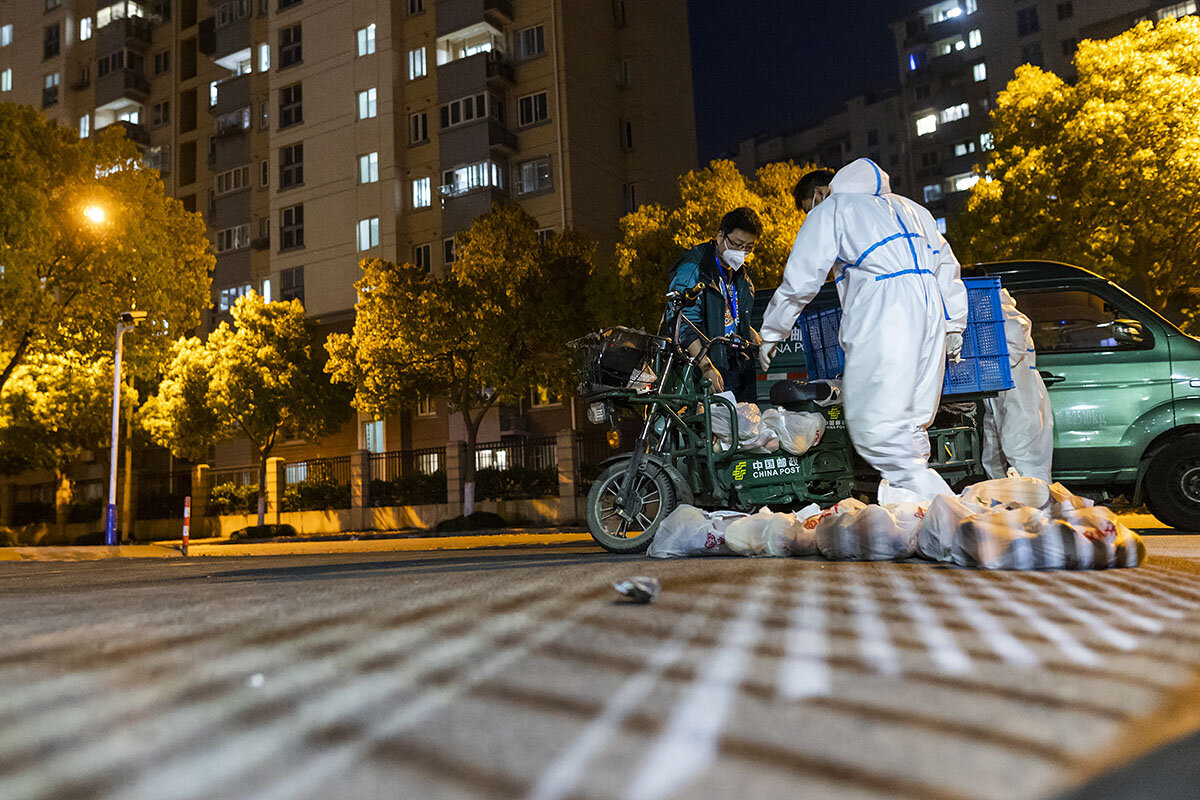
As the rest of the world moves away from lockdowns and other strict measures, China risks becoming stuck in cycles of costly lockdowns that wear residents thin, as I discovered in Shanghai.
Stuck inside
Searching for food felt surreal in the upscale but empty Shanghai neighborhood, with its yoga studio, posh eateries, and coffee shops. Amid shelves depleted from panic-buying, I found some milk, tuna, and crackers and hurried back to the hotel.
The next morning, the hotel told all guests to stay inside. Fresh out of quarantine, I was locked down again, this time along with the rest of Shanghai.
Glued to my window, I watched quarantine enforcers – nicknamed da bai, or “big white” – begin shouting through megaphones at a nearby intersection.
As it turned out, they were summoning residents for testing, carrying out an extraordinary order by Shanghai authorities to test the whole city in a single day. China’s zero-COVID-19 playbook is essentially this: Test everyone; quarantine positive cases and close contacts in hospitals or huge, makeshift shelters known as fang cang; and repeat until case numbers return to zero.
Individuals are linked to this regime through a digital health code on their phones that tracks their test results, locations, and even whether they’ve bought medicines related to COVID-19. It automatically assigns them a green, yellow, or red risk status that determines whether they can move around, are restricted at home, or are quarantined.
Complicating matters, how to obtain and keep the coveted green status can be opaque. Each city has its own system, and data is shared with police.
“This is like a Kafka novel!” exclaimed one traveler on the WeChat instant messaging group I’d joined of mostly Chinese people from my flight. We were all headed to Beijing, known for its extra-strict entry rules.
“The slightest mistake, and the whole game is lost,” said another.
Although strangers, we traded tips and cheered each other on, gaining some comfort in our solidarity.
Eroding trust
Faint at first, the unmistakable sound of screaming broke the night quiet. I pushed open the window. From apartments scattered across Shanghai’s high-rise horizon, people were crying out their frustrations en masse.
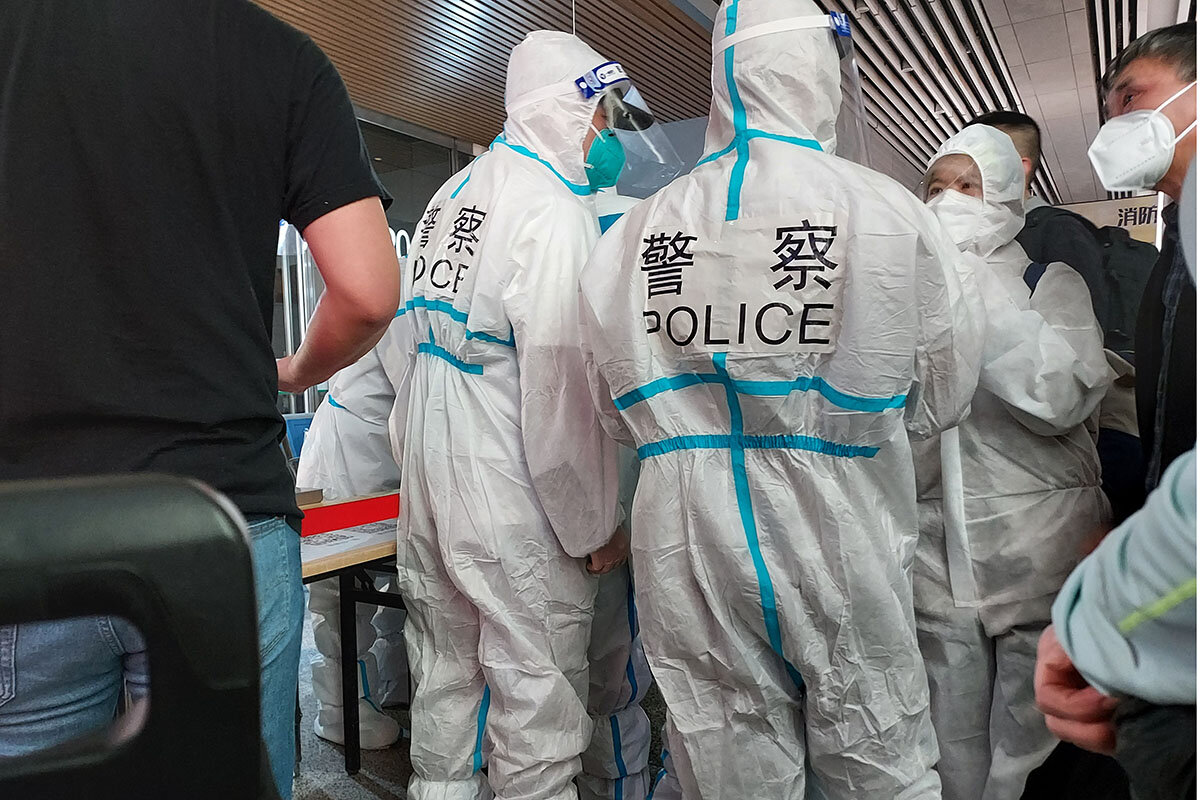
After weeks of denying a lockdown was imminent, Shanghai officials imposed it overnight – giving residents virtually no time to prepare. Despite nightly news coverage showing truckloads of vegetables arriving in the city, food and medicine shortages took hold because people were not allowed to go to the store, food delivery services were overwhelmed, and government distribution plans failed at “the last 100 meters,” officials admitted.
Tragedies soon followed. With hospitals prioritizing COVID-19 patients, people with other illnesses began to perish. One Shanghai nurse died after her own hospital refused to admit her. Shanghai has not reported any COVID-19 deaths during the latest outbreak.
“You can starve, but you can’t die from COVID,” said one Shanghai netizen, joining an outpouring of online complaints.
Anger surged over conditions in the cavernous quarantine facilities – one with 40,000 beds – and a policy, later adjusted, to separate parents from children.
As sporadic anti-lockdown protests broke out, the Shanghai Communist Party committee issued an open letter urging all party members to “dare to show their swords” and speak out against “rumors.” But many online comments suggest a lack of confidence in local leaders.
“Will there be a future for a Shanghai government that the masses are not willing to trust?” asked one person who claimed to be a party member.
Meanwhile, Beijing authorities ordered Shanghai to double down on its approach and sent in 2,000 medical personnel from the military and 30,000 more from the provinces.
Our Shanghai escape
On Friday, as the U.S. State Department warned U.S. citizens not to travel to Shanghai, my husband and I got the last-minute test results and precious green codes required to board a train to Beijing.
As the high-speed train accelerated out of the city, zipping north past green fields into the province of Jiangsu, I exchanged celebratory messages over the escape with others in my Beijing-bound WeChat group. But the elation was short-lived.
Changing trains in Nanjing, passengers from Shanghai were surrounded by scores of police in personal protective equipment who seized our ID cards and passports and herded us into crowded lines for a chaotic, hourslong “registration” process. Arguing and yelling at one another, the police lacked clear direction and gave none to us. After forcing us and many others to miss connecting trains, they began to quarantine the stranded travelers from Shanghai.
The Nanjing dragnet showed how desperate other provinces are to prevent the Shanghai outbreak from spilling onto their turf.
I managed to get our passports back and used a phone app to buy new northbound tickets. Over the next 24 hours, we were detained twice more. In the northern Jiangsu city of Xuzhou, quarantine workers held us overnight in a fenced area outside the station, where we slept on the sidewalk. The next day we made it to Beijing, but by then our Beijing green codes had turned yellow, so we were detained again for several hours by police at the Beijing station. A helpful Foreign Ministry official secured our release to a hotel, for another 14-day quarantine.
Almost immediately, our phones started ringing with dozens of calls from Nanjing, Xuzhou, Tianjin, and Beijing – all the cities we had passed through after leaving Shanghai. Word arrived that we may have been exposed to a positive COVID-19 case, and could be taken to a centralized quarantine facility.
In China today, that inadvertent exposure, call from police, and involuntary quarantine could come at any time. But after yet another negative COVID-19 test, we have been given permission to stay in the hotel.

A letter from
Images from Ukraine resonate on visit to ‘living ruin’ in Spain
Our reporter explores a battlefield in Spain that is a time capsule of a devastated city, a visit conducted in the shadows of another land war in Europe.

- Quick Read
- Deep Read ( 5 Min. )
When Belchite, a town in northeastern Spain, fell to Nationalists in 1937 during the country’s civil war, it was left in ruins. But Gen. Francisco Franco chose not to rebuild the town so that it could stand as a reminder of what he considered his opponents’ barbarism. A new town was built instead for survivors.
For decades, the Battle of Belchite was largely forgotten. But today it has become a popular civil war battlefield in Spain, a country that has long struggled with the legacy of its internecine conflict. Belchite is a window into the destructive power of modern warfare, at a time when Europe is recoiling at Russia’s invasion of Ukraine and its bombardment of Ukrainian civilians.
The parallels with Belchite’s history are hard to miss when you visit the site. Laura Soriano grew up in the area, but her school didn’t teach her about its particular history. Now she’s a tour guide at the site and helps school groups understand what happened there.
She points to the basement of a crumbled home. “That’s where women and children sought safety,” she says, “the same thing happening now in Ukraine.”
Images from Ukraine resonate on visit to ‘living ruin’ in Spain
Laura Soriano opens the thick wooden doors and invites us through. The facade, which bears the words in Spanish, “Blasphemy is Prohibited,” dates to the 18th century, and as we begin our tour I assume we are entering a church.
But stepping inside there are no walls. Instead, the arched doorway opens onto a street, now a dirt road, where homes, churches, a theater, dance hall, and bank stood before the Battle of Belchite in 1937. And it has sat like this for more than 80 years – a time capsule of utter wreckage and ruination.
At any time a contrast so stark and tangible – stepping from peace to war – would be disconcerting, but coming two weeks after the Russian invasion of Ukraine made it feel even heavier, and our tour guide was quick to draw the parallels. Just as Russian bombs had destroyed a maternity ward in Mariupol – and were later to strike a theater where Ukrainians had taken refuge – so had destruction rained down on civilians here.
Ms. Soriano points to the basement of a crumbled home. “That’s where women and children sought safety,” she says, “the same thing happening now in Ukraine.”
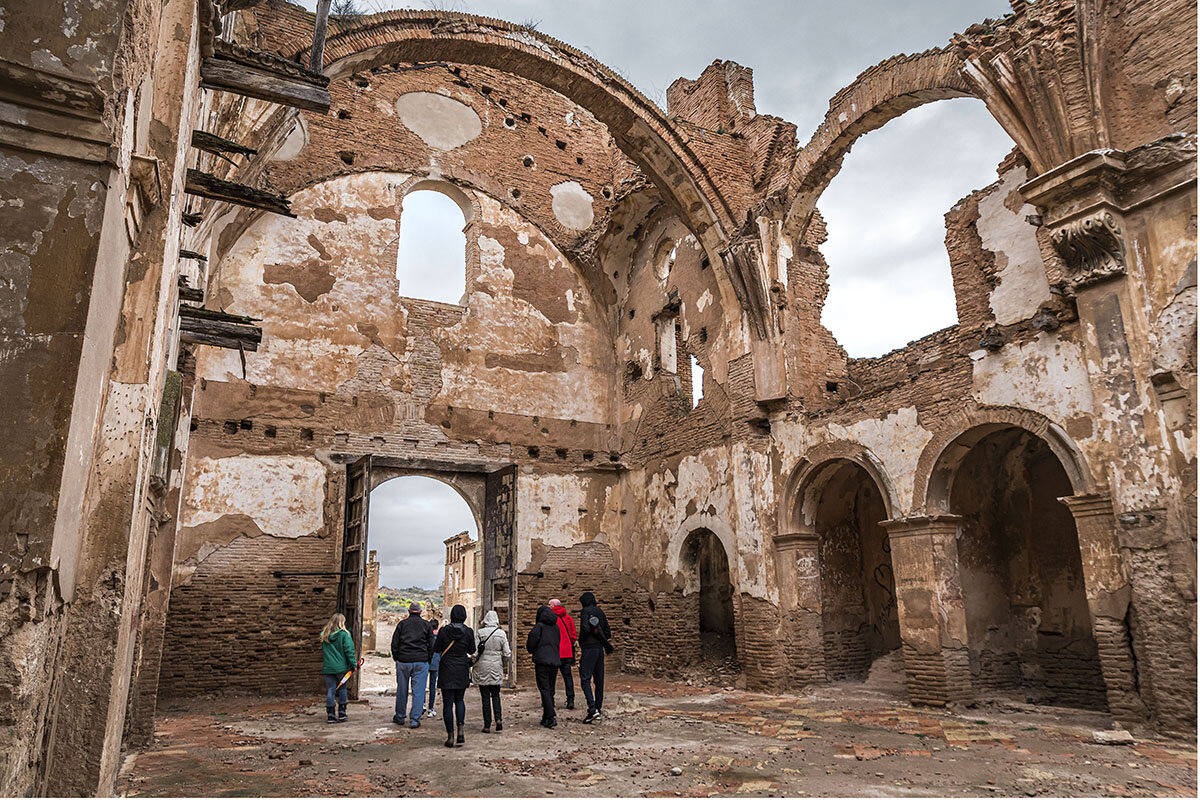
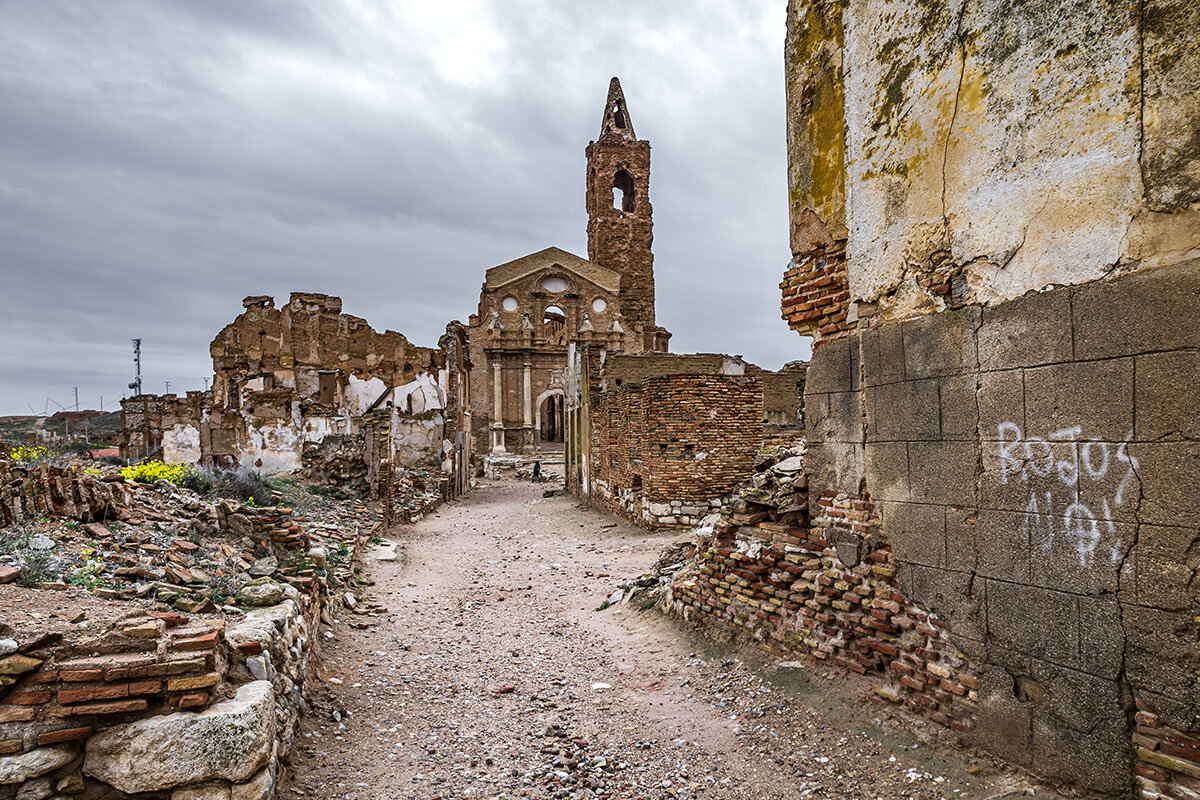
Belchite isn’t the most well-known battle of the Spanish Civil War, which began in 1936 with a coup led by Gen. Francisco Franco. But it’s one of the few places in contemporary Spain where you can feel the horrors of the war, not just read about it, visit a memorial, or see it depicted in art or film. And the site’s own evolution in meaning to Spain may point to a political maturation underway as societies confront their pasts and the ideologies that have torn them apart.
Tucked in the barren hills of Aragon in northeastern Spain, Belchite was initially controlled by Franco’s Nationalist forces, before it fell to the Republicans in August 1937 during a 14-day battle that became an international symbol of Spain’s divisions. It also exemplified the polarized politics of Europe in the 1930s.
Six months later, Franco’s forces retook Belchite.
About 5,000 died on both sides. But Franco decided to keep Belchite in ruins instead of razing it to rebuild. It was an act of propaganda: The dictator eventually built a new town next door, while leaving the old one untouched as a constant reminder of the barbarism of his enemies.
It was not a memorial to the dead or an act of peace. “At no point in the near 40 years of dictatorship did Franco have the slightest interest in what we might call reconciliation,” says Paul Preston, a renowned historian of the Spanish Civil War and author of “The Spanish Holocaust,” among other books on the conflict.
But Franco’s “living ruins” eventually did become a symbol for peace, and for many a stark expression of the barbarism of fascism.
In the early year of Spain’s transition to democracy after the death of Franco in 1975, the site of Belchite slipped into obscurity, says local resident Juan Carlos Salavera Pardos, who administers a Facebook page called “Belchite, Between Oblivion and Memory.” It’s only in recent years it’s emerged as an anti-war monument.

Bearing witness
Walking through the abandoned town gives a sense of bearing witness on this day as heavy storm clouds gather. Bullet holes mark the facades. At one of the standing churches, visitors must tread carefully because gaping holes from missiles have made parts of the roof unstable.
The acts of war from 80 years ago continue to mark lives here. A mass grave was uncovered last fall, and two weeks before our visit in March a bomb lodged high up into the wall of the cathedral was finally removed. All these years later, authorities discovered it had been active this whole time.
Spain has had an uncomfortable relationship with the legacy of its civil war – preferring to forget it rather than confront it. For years Belchite was an open site and anyone could roam around; many took away materials from roofs and old doorways. Growing up here, Ms. Soriano didn’t learn anything at school about the battle site.
Today it’s open to guided tours, and Ms. Soriano tells the complex history of damage wrought by both sides. School groups often join her tours, she says, to learn about conflict resolution and empathy-building. They talk about current wars. She says they will be redesigning the curriculum to include Russia’s invasion of Ukraine.
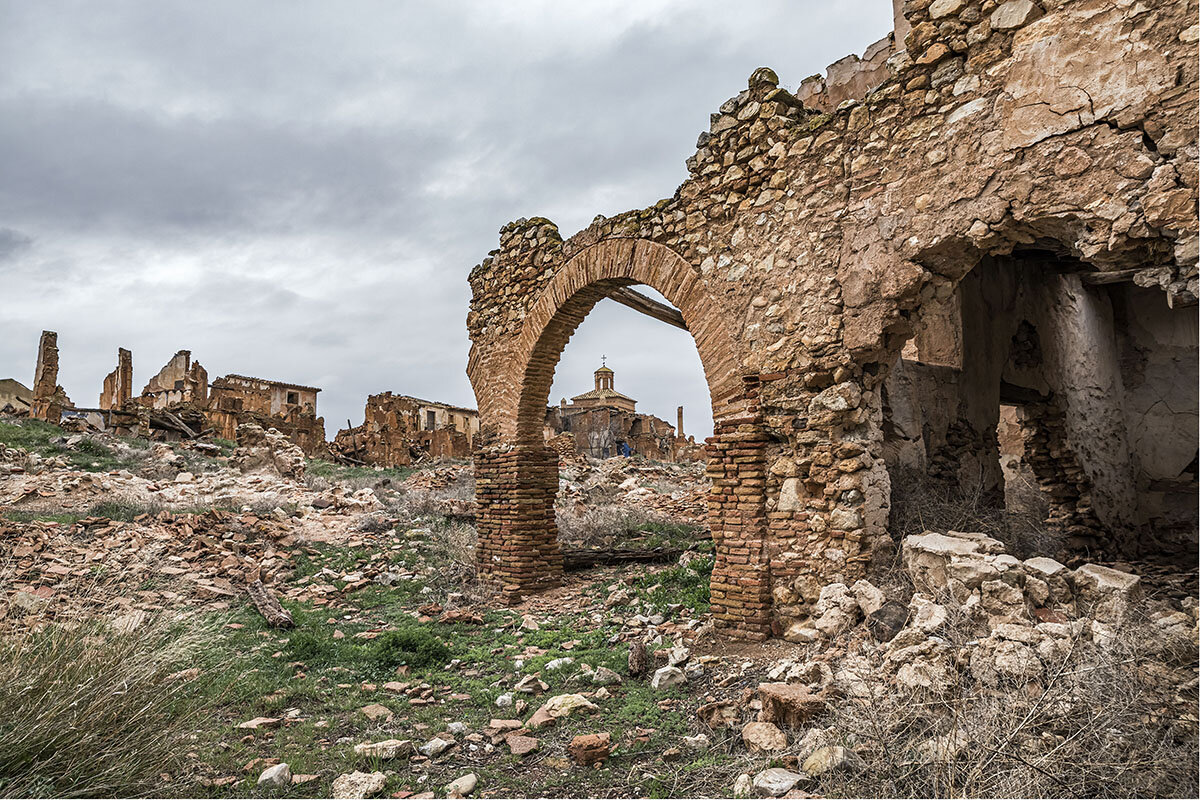

David Malet, an associate professor of justice at American University who studies foreign fighters, says he sees an evolution in postwar societies. The norm used to be that killing sites were maintained to remind us of what “they” did, but it’s become common for societies to memorialize sites that remind “us” of what “we” did. He sees this transition as a sign of “political maturity.”
The new town of Belchite is a bustling place – a typical Spanish town where seniors pack the cafes at midmorning. But the memory of war has always been close. In a town of 1,500, almost everyone carries a story about the 14-day siege.
As Ms. Soriano recounts the names of owners of various houses and businesses in old Belchite, these are not just the names of historic figures but people her great-grandparents knew. Her grandmother, who just turned 89, was 4 years old during the Battle of Belchite. “She was just asking us at lunch yesterday, ‘How can war in Europe be happening again?’”
“For me,” says Ms. Soriano, “it pains me to see what families are going through, everyone leaving their partners, their spouses. They don’t know if they will live or die. They don’t know where they will be going or where they will be ending up. They just know they are far from home, and they don’t know if they will have a home if they return,” she says. “I do think we feel it closer here.”


In this Mississippi city, public art points a way forward
In seeking to build community spirit and keep young residents from moving to greener urban pastures, where did Hattiesburg, Mississippi, turn? To something as simple as paint on walls – part of rising global appreciation for the importance of public art.

- Quick Read
- Deep Read ( 6 Min. )
-
By Xander Peters Special correspondent
Like most U.S. cities, Hattiesburg temporarily shut down at the start of the pandemic. One thing the Mississippi city didn’t stop was its creation of public art. In fact, in a city where dozens of murals depict everything from its musical heritage to sprays of color representing a poet’s hope, leaders leaned into the idea that art builds community health.
The effort earned national recognition this year when Travel & Leisure magazine noted Hattiesburg as one of the world’s top public art destinations, alongside creative capitals like Berlin, Paris, and New York.
But the core objective isn’t to please out-of-towners, says Shawn Harris, a Downtown Hattiesburg Association board member who’s volunteered throughout the city’s beautification project since 2014.
“If you make your residents happy, tourists will come and appreciate those things, but you’re not ostracizing your residents at that cost,” Mr. Harris says. “It’s really about community development and not economic development.”
The story has larger lessons, says Ellen Winner, a professor specializing in art psychology at Boston College. The process of viewing public art, she says, “raises our morale, connects us to the arts, connects us to each other, it makes us think, and it raises our mood.”
In this Mississippi city, public art points a way forward
Madison Rux lives just outside Hattiesburg, Mississippi, but she finds herself in the city often. Sometimes it’s for work, sometimes for her social life. Sometimes it’s to get a moment to herself to think clearly, alone, while she strolls the city until she runs into one of her favorite works of public art.
It’s of a large, vibrant hummingbird, a painting by Texas artist Avery Orendorf titled “Spread Your Wings.” It reminds Ms. Rux of herself, and of the trials she faced as a teenager. She relocated from Central Texas to Mississippi six years ago, after her adopted parents kicked her out of their home at age 17. She had to reinvent herself and navigate the world on her own.
“Growing up, I was always the person my parents wanted me to be,” Ms. Rux says. “I had to figure out who I was again. It was a journey. I had to spread my wings and fly on my own.”
For a small city with a population hovering near 50,000, Hattiesburg is teeming with life, and purposefully, through color. On some corners, bright paintings like the hummingbird spring from sunbeams as if they’re coming to life. On others, the paintings are nods to the city’s culture, such as a mural by Mississippi artist Amy Giust – an abstract rendition of a weekend out on the town. It’s in part an ode to the state’s place in American music history.
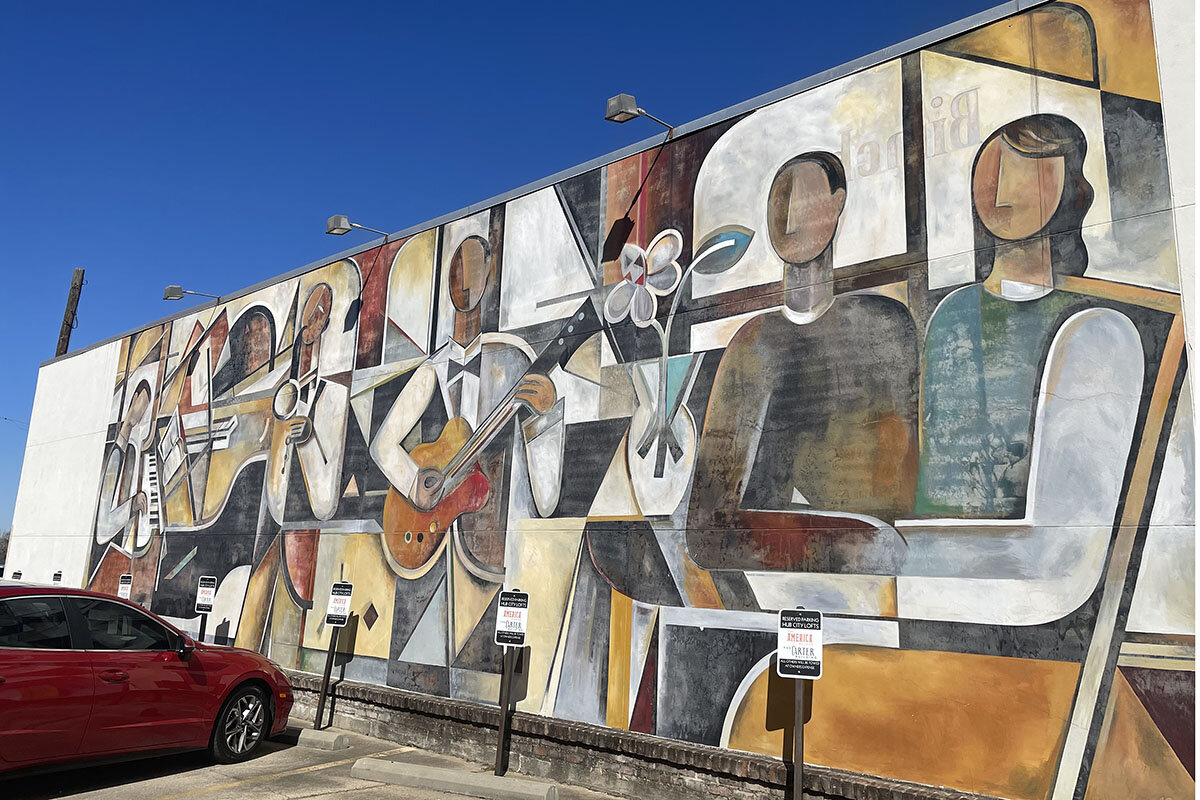
Block after block, artwork after artwork, Hattiesburg has declared public art as its theme. There are as many as 46 public art installations like these citywide – including at least 35 murals plus sculptures and other mediums. The public art presence is a defining element for a city that’s better known for its student population divided between the University of Southern Mississippi and William Carey College. With impetus from the Hattiesburg Alliance for Public Art, the city aims to decorate its rustic streets so they inspire those who grace them.
The city’s effort to immerse itself in art earned national recognition earlier this year when Travel & Leisure magazine noted Hattiesburg as one of the world’s top public art destinations, alongside creative capitals like Berlin, Paris, and London. In the U.S., Miami and New York City were the only cities ranked ahead of humble Hattiesburg; Philadelphia was listed one spot below.
But the goal isn’t necessarily about garnering more tourist dollars, says Shawn Harris, a Downtown Hattiesburg Association board member who’s volunteered throughout the city’s beautification project. Rather, it’s about creating a better space for the community.
“That’s the model we follow in Hattiesburg. If you make your residents happy, tourists will come and appreciate those things, but you’re not ostracizing your residents at that cost,” Mr. Harris says. “It’s really about community development and not economic development.”
Art “raises our morale, ... connects us to each other”
In fact, researchers who study people’s response to aesthetics say art affects our outlook and thoughts.
“The arts are somewhat on the fringes” of mainstream psychological study, says Ellen Winner, a professor specializing in art psychology at Boston College. “But they’re coming more into the center now, as people are realizing the importance of art.”
Even momentary encounters with art can be healthy.
As Professor Winner explains, public art can help us feel more connected to our immediate surroundings and to artists. It wakes us up to the world around us. It makes us ask ourselves how another person interprets the same piece of work through their own lens. It makes us wonder.
The process of viewing public art “raises our morale, connects us to the arts, connects us to each other, it makes us think, and it raises our mood,” Dr. Winner says.
That was one key goal at the inception of the Hattiesburg Alliance for Public Art in 2014.
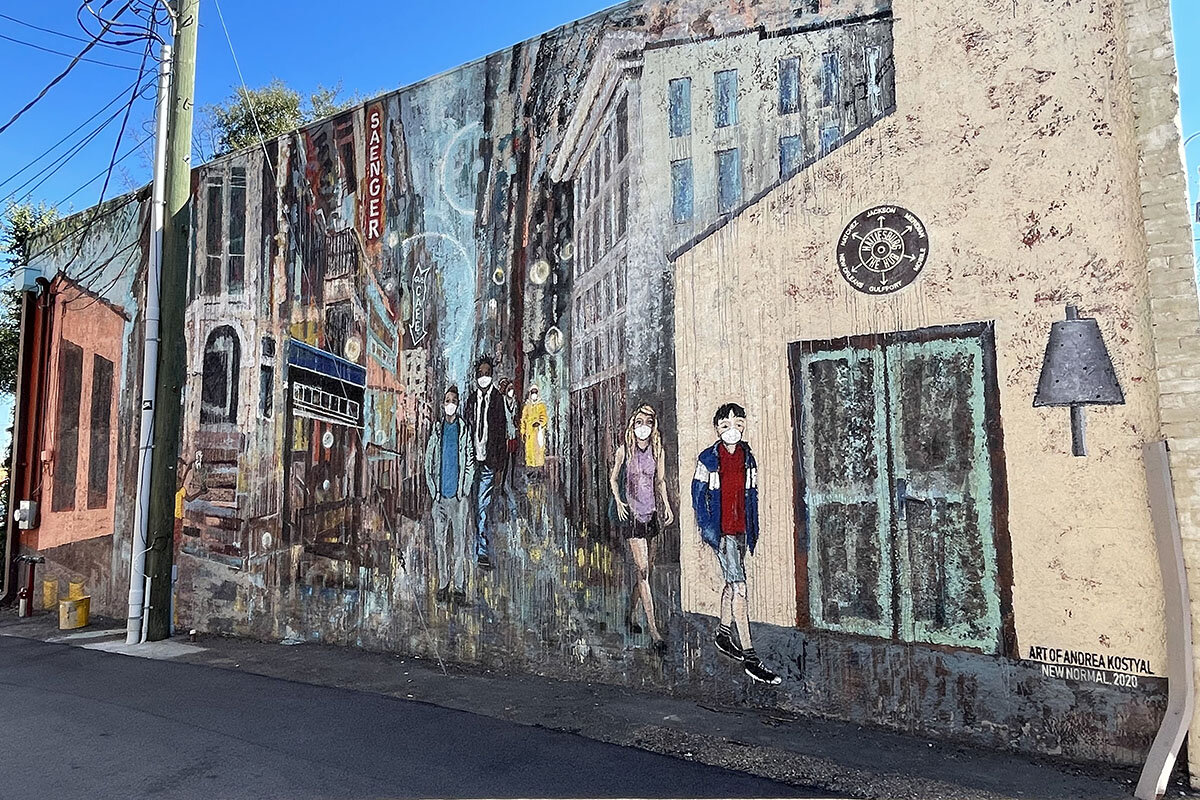
Sculptures and murals began lighting up the city’s downtown streets, beckoning life and excitement for residents. As installations sprouted, city leaders began exploring ways to better allow residents and tourists to explore them. Then came the pandemic.
Like most U.S. cities, Hattiesburg temporarily shut down. Its public art display didn’t. In fact, city leaders decided to lean into commissioning more public art, creating an escape for locals. The creators are about half local, with the other half from other Mississippi artists and those working on the national stage.
The Hattiesburg Alliance for Public Art and Visit Hattiesburg collaborated last year to implement the Hattiesburg Public Art Trail, a socially distanced, outdoor activity. Lately, the city has also begun turning its public utility boxes – those gray metal boxes often seen on city street medians – into public art installations.
It’s about “making things more beautiful,” says Ricardo Moody, a local high school art teacher who has several public installations in Hattiesburg, including several murals and a utility box.
The theme of community is central to his abstract work. Mr. Moody points to a mural he was asked to produce on the side of a local business owner’s building. It’s titled “Wonderful Day” – a splash of warm colors, centered around a quote by civil rights pioneer Maya Angelou: “This is a wonderful day. I’ve never seen this one before.” Several local high school kids came to help Mr. Moody produce it – resulting in a design that incorporated their school colors.
“The plants that I painted there, the leaves, is having to do with growth,” Mr. Moody says in describing his work. And much like Hattiesburg, “as things grow, they mature and thrive.”
Building a city’s future
Over the next five years, Hattiesburg hopes to become “the city of 100 murals.” That’s the directive handed down from Mayor Toby Barker.
It’s an achievable goal, says Kristen Brock, director of programs and promotions at the community advocacy group VisitHBURG.
“Hattiesburg has embraced this public art venture that we are on,” Ms. Brock says, noting how the effort has received support from residents, business owners, and organizations alike. “Then on the flip side, we have seen huge interest from visitors coming to Hattiesburg. We estimated that we had interaction from about 300,000 people last year who were interested in our public art.”
For residents like Mr. Harris of the downtown association, it’s affirming to see Hattiesburg receive national attention.
“It’s so easy to make the national news for something negative,” Mr. Harris says. He describes their effort as “a testament to following a plan and understanding what your community needs.”
Residents and community leaders alike also hope their efforts counter some of Mississippi’s ongoing obstacles such as brain drain, with outmigration that has included a period of the highest rate of millennial exodus in the nation.
“I think public art plays a role in making [talented individuals] realize they can have a future in Hattiesburg,” Ms. Brock says.
It’s the city’s way of building community, she adds.
But for community members like Ms. Rux, the city’s art display is a way of building herself.
On her strolls alone through Hattiesburg, Ms. Rux makes a point to visit the hummingbird mural. She also likes to take the time to stroll a little bit further across town to a painting of a red cardinal. She grew up believing that cardinals were the souls of loved ones who have died.
Ms. Rux likes to think of the cardinal as her late grandmother checking in on her.
“Whenever I don’t see a cardinal for a little while,” Ms. Rux says, “I go over there.”

Books
Putting conflict in context: A reading list for Ukraine
Can we better understand the present by examining the past? Our reviewer has chosen key books that probe the history behind Russia’s invasion of Ukraine.
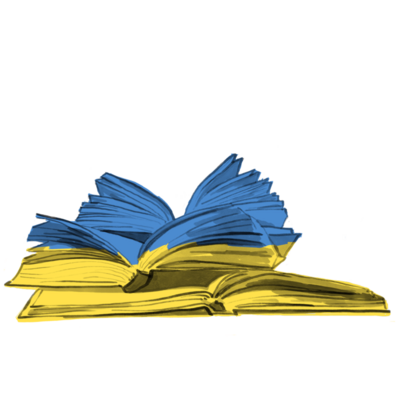
- Quick Read
- Deep Read ( 4 Min. )
-
By Steve Donoghue Contributor
As Russian forces barreled into Ukraine on Feb. 24, a natural response of readers surveying their news feeds was, “How is this happening?” To approach this question, readers may wish to dig deeper into the history behind the conflict, using books as their guide. For example, it can be useful to look at earlier events, such as Russia’s invasion of Crimea, and trace President Vladimir Putin’s ambitions to bring former Soviet territories under his control. These aspects are covered in depth in “Beyond Crimea: The New Russian Empire.”
Readers who wish to learn more about Ukraine itself can find a millennia’s worth of that nation’s history, along with its significance, in “The Gates of Europe: A History of Ukraine.” The book takes what our reviewer calls “a scrupulous, panoramic look” at the long and convoluted relationship between Ukraine and Russia.
The war in Ukraine has also cast a spotlight onto the NATO alliance, and what its members are prepared to provide the Ukrainians to defend their homeland. “Enduring Alliance: A History of NATO and the Postwar Global Order” explains how NATO began, what its limitations are, and how the alliance functions today.
Putting conflict in context: A reading list for Ukraine

When Russia invaded Ukraine on Feb. 24, even avid news watchers throughout the West were stunned. Despite the well publicized military buildup of Russian forces on the Ukrainian border for many months, it seemed on some level unbelievable that Russia would launch a land war on a European nation while, thanks to social media and the 24-hour news cycle, the whole world could watch – and unite in sympathy with the valiant Ukrainians.
One natural response on the part of all these shocked onlookers was to look for books to help them make sense of what they were seeing in their news feeds.
They’ve looked, for instance, for accounts of precedents to Vladimir Putin’s attempt at a land-grab in Ukraine – the largest and most noticeable of which was his 2014 attack on Ukraine’s Crimean Peninsula. That’s the opening emphasis of 2016’s “Beyond Crimea: The New Russian Empire” by Agnia Grigas, an experienced political analyst who examines what can be studied of Putin’s mind frame in attempting to reconstitute a 21st-century version of the vanished Soviet Union.
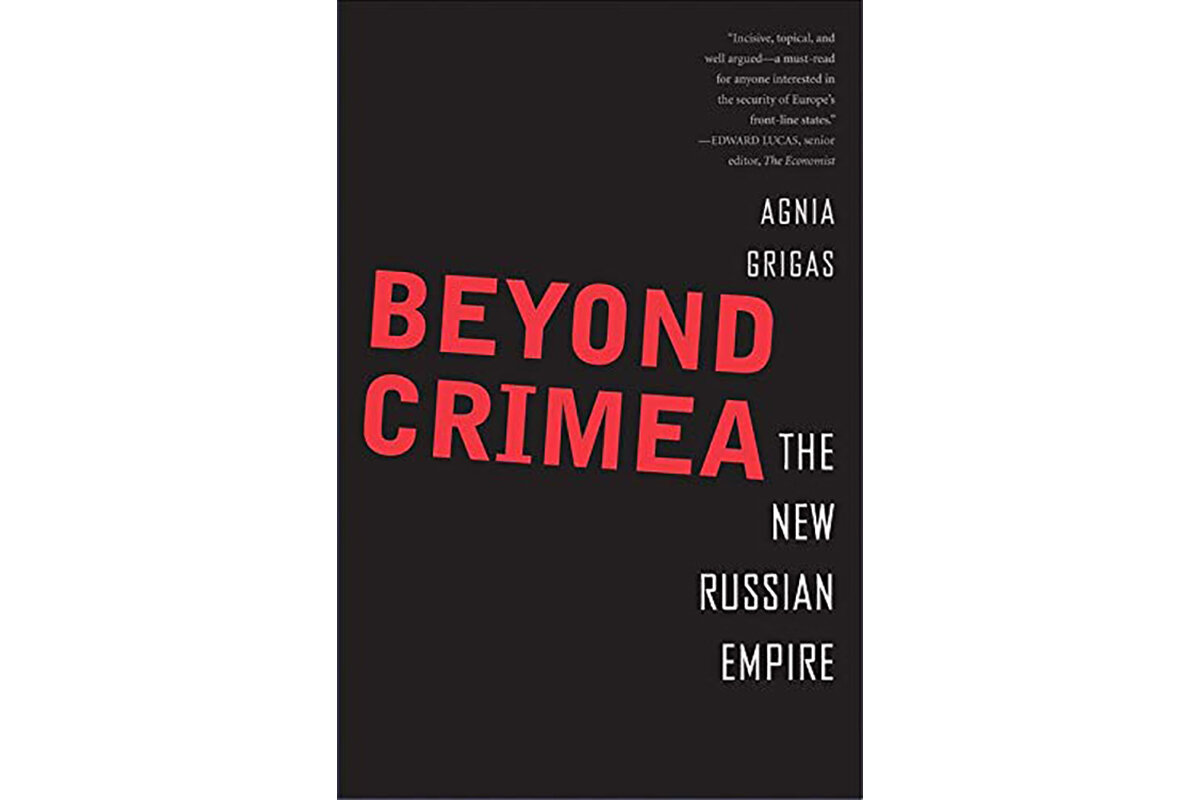
That annexation of Crimea wasn’t acceptable to Ukraine, of course, and the result was war, which journalist Tim Judah covers in granular detail in his gritty and intensely moving book “In Wartime: Stories from Ukraine.” The fighting Judah covers can’t help but read as a prelude to the larger-scale violence filling the news today, but the stories Judah relates are more detailed and focus on the war’s effects on ordinary Ukrainians. (I reviewed “In Wartime” for the Monitor back in 2016.)

Readers anxiously studying the headlines have likewise looked for books about the attacked country itself. The best of these is Serhii Plokhy’s “The Gates of Europe: A History of Ukraine,” which came out in 2015 and takes a scrupulous, panoramic look at over a thousand years of Ukraine’s history – including its long and convoluted relationship with Russia. Plokhy is a tremendously engaging writer, and “The Gates of Europe” is an absorbing reading experience that well deserves its newfound bestseller status, however tragic the reason.
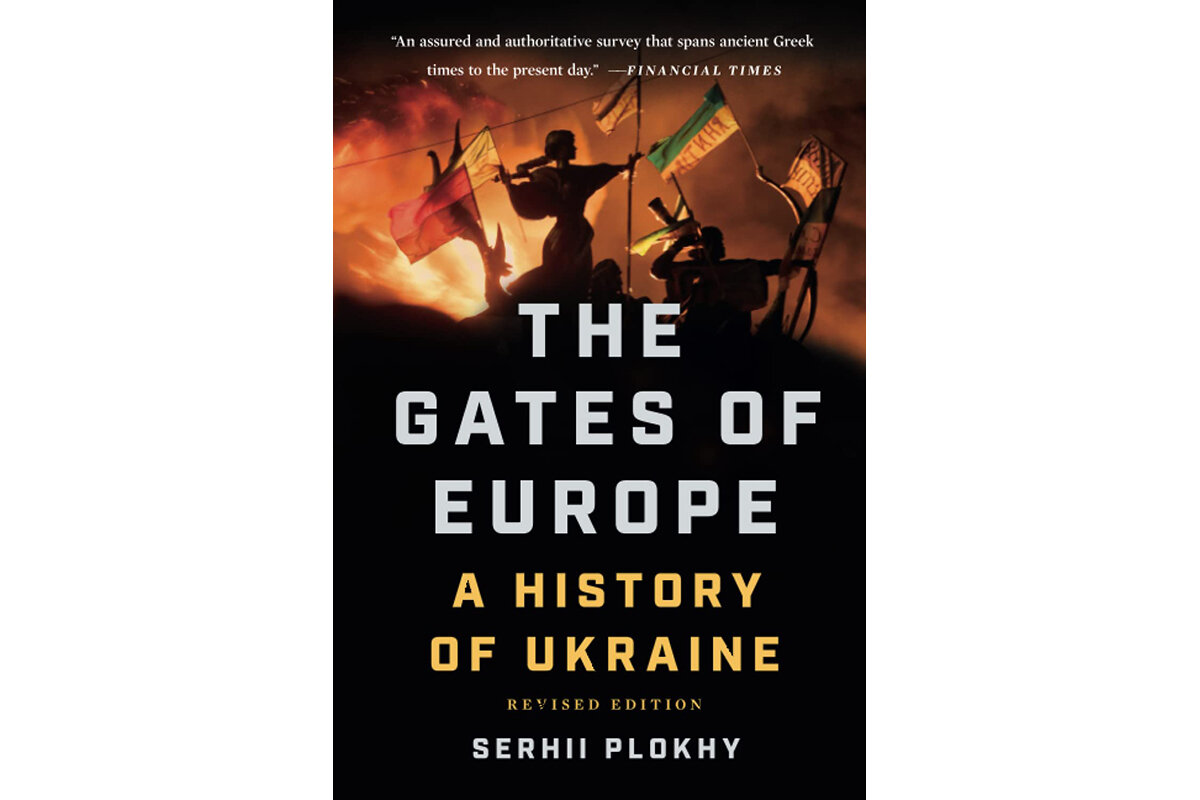
One of the most devastating chapters in Ukraine’s history gets its own excellent book in Anne Applebaum’s “Red Famine: Stalin’s War on Ukraine” from 2017, which details Stalin’s policy of “Sovietization” in Ukraine, which resulted in a consciously planned and mercilessly executed widespread famine that killed many thousands among Ukraine’s peasantry and left deep scars on the fabric connecting the two countries. In the course of her study, Applebaum examines the hot-button topic of Ukraine’s nationalist aspirations, the dreams of its people – and the long-standing Russian urge to quash them.
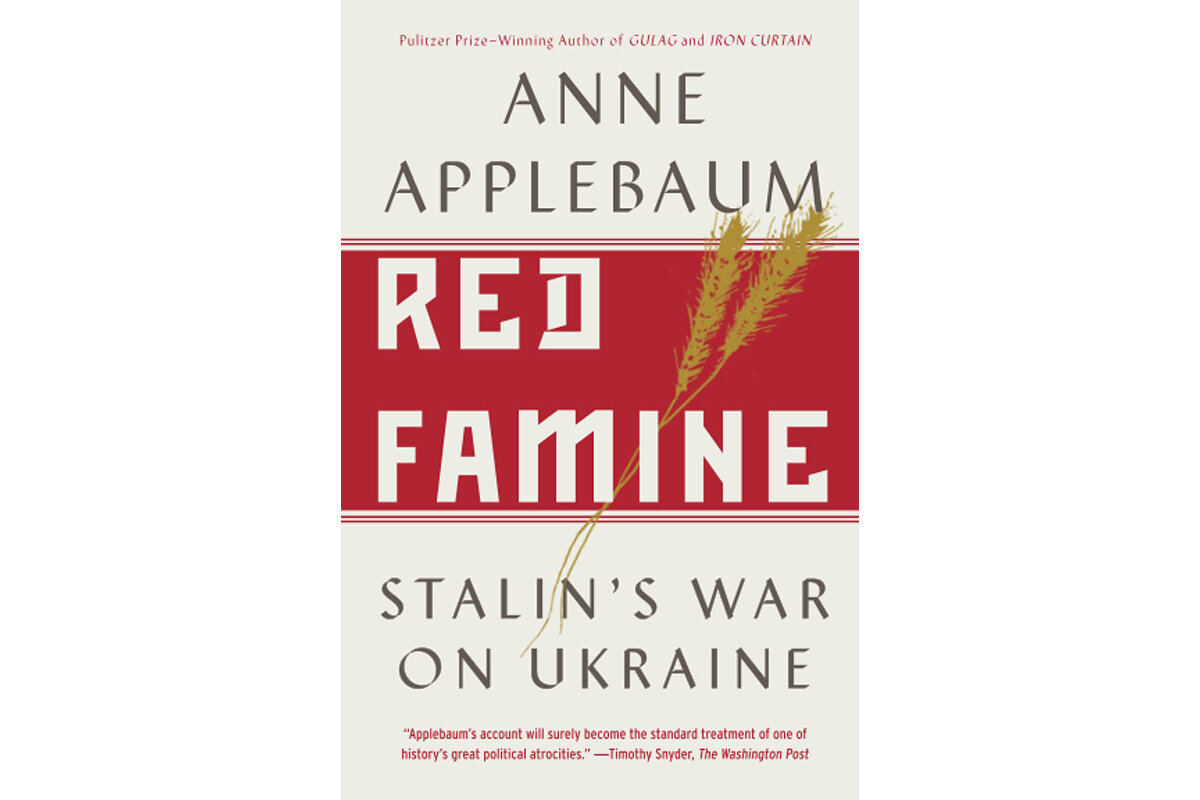
The dreams of ordinary Ukrainian people are at the center of Anna Reid’s 2015 book “Borderland: A Journey Through the History of Ukraine,” in which she travels the country and talks to people from all walks of life. Her book is evocatively written, and she matches the personal portraits she relates with a sweeping history of the country on a broader canvas. In unsure hands, this combination of wide and narrow focus can go wrong, ending up seeming to trivialize both. But Reid invests both concentrations with extensive research and rich empathy.
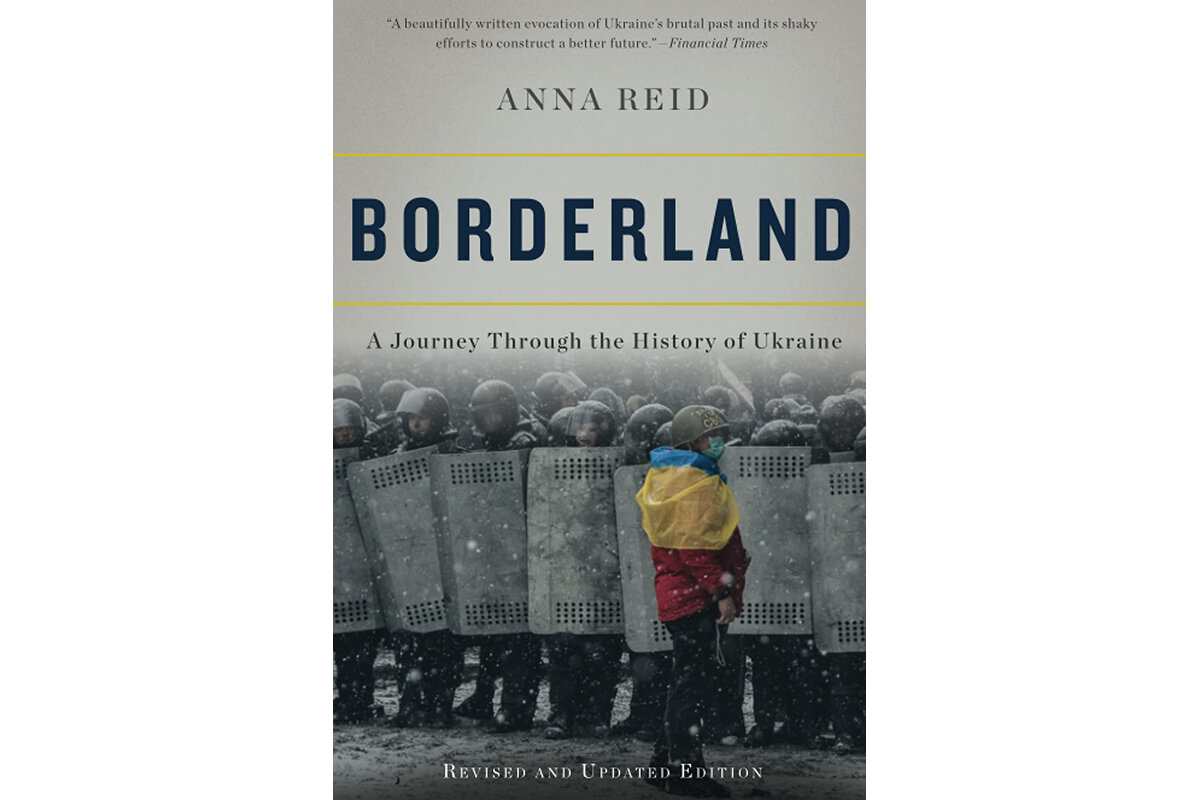
Reid’s book moves readers right up to relatively present-day events, and those events touch the wider international world mainly because of one overwhelming tension that’s on the minds of even the most disinterested observers: What are the chances that this conflict in eastern Ukraine could spill out in the larger arena of first Europe and then the rest of the world?
Much of the answer to such a question depends on NATO, which is why all eyes have turned to that alliance and its stated intentions, whether to confront Russia directly or merely to sanction the country into economic oblivion and supply materiel to Ukraine. NATO’s growth near Russia’s Western border was clearly a preoccupation and a pretext for Putin, and the organization’s prominence in the news has led many people to wonder just what it is and what it can do.
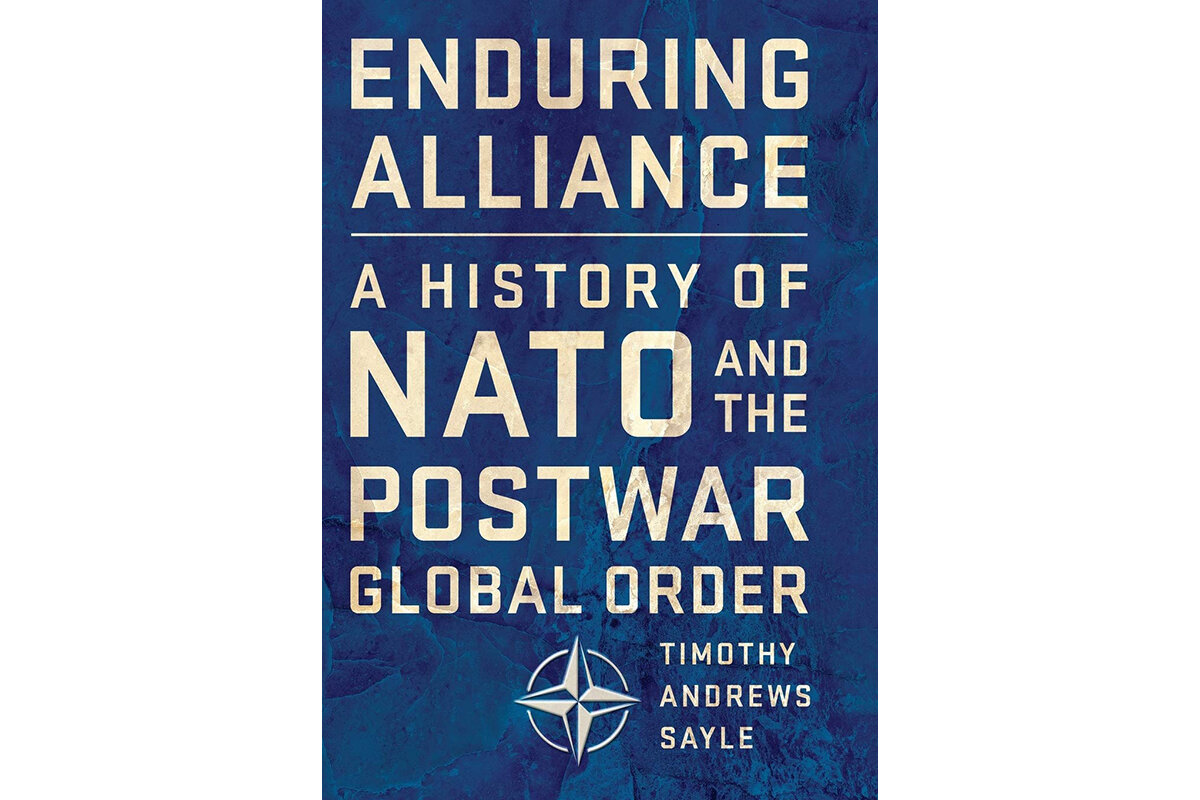
One valuable resource in understanding these matters is “Enduring Alliance: A History of NATO and the Postwar Global Order” by Timothy Andrews Sayle, which came out in 2019 and details the formation and the limitations of NATO. It’s a keen assessment of how NATO functions.

And the deepest concern lurking behind such issues is, inevitably, the question of nuclear war. Will Russia and the West risk nuclear war over a couple of provinces in eastern Ukraine? For this, Michael O’Hanlon’s penetrating 2019 book “The Senkaku Paradox: Risking Great Power War Over Small Stakes” becomes essential reading – and perhaps provides a glimmer of hope. As supply chains and social media have proliferated in reach and power, economic and political pressures have perhaps become more effective. Worse outcomes – and the worst outcome – may yet be avoided.
Other headline stories we’re watching
(Get live updates throughout the day.)The Monitor's View
A war’s end by light of the innocent?
- Quick Read
- Deep Read ( 2 Min. )
-
By the Monitor's Editorial Board
Many a war has ended when an outside mediator realized civilians caught in the conflict are useful tools for peace. The plight of innocent people can bind the warring parties. Shared empathy then yields shared trust during a negotiation. This tactic helps explain a surprise truce in Yemen after seven years of war. If the pause in violence leads to a just peace, the survivors could be seen as victors rather than victims.
The truce that began April 2 reflects shifts both in and around this civil war on the Arabian Peninsula. Inside Yemen, a military solution is clearly out of sight. Since late 2021, a new United Nations mediator, Hans Grundberg, has been listening to women’s groups, tribes, and civil society about their priorities. The result was a truce that includes meaningful economic relief and a broadening of political participation.
Credit for the budding peace goes to Yemeni civilians. They “are united in their desire for the truce to be upheld, renewed, and consolidated as a step towards peace,” said Mr. Grundberg. By listening to their first priority – a bolstering of the economy – mediators have widened the door to a political peace.
A war’s end by light of the innocent?

Many a war has ended when an outside mediator realized civilians caught in the conflict are useful tools for peace. The plight of innocent people can bind the warring parties. Shared empathy then yields shared trust during a negotiation. This tactic helps explain a surprise truce in Yemen after seven years of war. If the pause in violence leads to a just peace, the survivors could be seen as victors rather than victims.
The truce that began April 2 reflects shifts both in and around this civil war on the Arabian Peninsula. The two outside protagonists, Iran and Saudi Arabia, appear tired of this particular proxy fight for Middle East dominance. Inside Yemen, a military solution between armed factions is clearly out of sight. Since late 2021, the timing has been ripe for a new United Nations mediator, Hans Grundberg, to bring an approach that involves listening to women’s groups, tribes, and civil society about their priorities.
The result was a truce that includes meaningful economic relief and a broadening of political participation. Saudi Arabia has dumped its key and unpopular ally in Yemen, former President Abd-Rabbu Mansour Hadi. Last month, it also helped set up a new, broad-based leadership council that might open a door for Iran-backed Houthi rebels to agree on shared governance.
Ships are being allowed into a key port bringing badly needed fuel. Commercial flights into the Sanaa airport have resumed. The warring parties agreed to open roads to allow aid, trade, and people to flow between contested regions. Both Saudi Arabia and the United Arab Emirates promised a $3 billion aid package.
Mr. Grundberg’s multitrack approach relies on continued efforts to give voice to the millions of Yemenis still suffering under one of the world’s worst humanitarian crises. Direct talks toward a political settlement have yet to begin. The U.N. does not have people on the ground to monitor the cease-fire.
Yet, says the Swedish diplomat, “Across the plurality of voices, a common message has emerged – Yemenis want the war to end, and they want a just and durable peace.”
The truce was also well timed to coincide with the Muslim holy month of Ramadan. The time for fasting and prayer may help melt one of the other tensions in Yemen: rivalry between Islam’s branches. Mr. Grundberg’s work was also aided by nearby Oman, a small country that plays a pivoting mediating role in the Middle East, as well as pressure by the United States on Saudi Arabia and Iran.
Yet credit for the budding peace goes to Yemeni civilians. They “are united in their desire for the truce to be upheld, renewed, and consolidated as a step towards peace,” said Mr. Grundberg. By listening to their first priority – a bolstering of the economy – mediators have widened the door to a political peace.

A Christian Science Perspective
Each weekday, the Monitor includes one clearly labeled religious article offering spiritual insight on contemporary issues, including the news. The publication – in its various forms – is produced for anyone who cares about the progress of the human endeavor around the world and seeks news reported with compassion, intelligence, and an essentially constructive lens. For many, that caring has religious roots. For many, it does not. The Monitor has always embraced both audiences. The Monitor is owned by a church – The First Church of Christ, Scientist, in Boston – whose founder was concerned with both the state of the world and the quality of available news.
Don’t give worry a way in
- Quick Read
- Read or Listen ( 4 Min. )
-
By Susan Stark
When we open our hearts to God’s protecting love for all, we’re “caulking our arks” – equipping ourselves to express patience, compassion, and courage rather than succumb to worry and fear.
Don’t give worry a way in

These past couple of years, everyday people have become heroes: teachers, social workers, grocery clerks, health-care workers, farmers, neighbors. Their compassion has helped others deal with worry, or what one young boy described, according to The New York Times, as “sad panic mode.”
When I hear of people surviving very unsettling events with their courage and love intact, I remember the story of Noah’s ark (see Genesis, chaps. 6-9). Noah was told by God to build a boat, or ark, and it took him, his family, and two of every kind of animal safely through a flood that covered the earth.
I find one of God’s instructions to Noah about how to build this ark especially interesting. Noah was told to caulk it with pitch, a sealant that would keep the water out.
We can ask ourselves, “Am I caulking my ark?” In a spiritual sense this could mean, “Am I trusting in God, so that waves of heaviness and anxiety can’t gain entry into my thoughts? Am I able to buoy up others so that they don’t sink into worry?”
The answer to those questions is in understanding and expressing the spiritual attributes, such as intelligence, joy, love, and fearlessness, that belong to God’s man, the likeness of divine Spirit. This is the real you and me – and the real friend, neighbor, and stranger we meet daily.
As this spiritual likeness, we are each the child of God, divine Love, steered by love and not by its inverse, worry. Courage is a natural response when we are moved by love. Mercy has the power to take away anger in stressful circumstances. And unselfishness is a recognition that there is always something positive to do for others. These qualities are like the pitch that caulks a boat.
Caulking our ark doesn’t mean sealing ourselves off from others or the concerns that they face. It’s about following the Bible’s instruction to keep out fear. Christ Jesus often said, “Fear not,” as both a comfort and a command. He got people out of dangerous circumstances – including sickness, hunger, and storms – by taking away their fears and healing them.
Jesus treated evil and the fear of it as one and the same thing, and as unreal and powerless, because evil isn’t created by God. How else could God keep us safe than by being the only real power and presence in our lives right where what we fear appears to be?
Christ, the divine nature of Jesus, gave him clear judgment about what is spiritually real and what isn’t. Jesus could heal because he knew that God, perfect Spirit, could not create a material, fearful mortal – the opposite of the indestructible substance of Spirit. His prayers destroyed the mesmeric effects of fear in the thoughts of those he healed. Jesus replaced their belief that life is wholly or partially matter-based – a belief that engenders fear – with the truth that man is God’s spiritual creation.
A truth like this brings love to the forefront of our thoughts – God’s love for us, and our love for God and each other. Each of us is forever protected by the infinite Love that has made us, as Noah’s story bears out. God’s creation is as indestructible as God, the creator. We are essential to God as the expression of all that is spiritually real and true.
Mary Baker Eddy, who discovered Christian Science, searched the Bible and its stories for their spiritual meaning. A scriptural glossary in her book “Science and Health with Key to the Scriptures” includes definitions of “Noah” and “ark.” The one for “ark” reads, in part, “God and man coexistent and eternal; Science showing that the spiritual realities of all things are created by Him and exist forever” (p. 581).
Knowing that God, Spirit, preserves and protects “the spiritual realities of all things” shifts our attention from worrisome events to what is powerfully present – God, good – and our ability to know ourselves as the spiritual offspring of God, safe and sound.
Like Noah, we have a precious cargo to protect: our thoughts about our world, our community, our family, and ourselves. It is Christ, the spirit of Truth, that speaks to us today and tells us that worry doesn’t have the upper hand. When we know that all are preserved by God and exercise that spiritual conviction in courage, joy, and compassion, we can be sure that worry won’t have a way in.
Adapted from an editorial published in the March 7, 2022, issue of the Christian Science Sentinel.
For a regularly updated collection of insights relating to the war in Ukraine from the Christian Science Perspective column, click here.

A message of love
Fun that floats

A look ahead
Thanks for joining us today! Come back tomorrow. Senior Washington correspondent Peter Grier will have Part 1 of a new series looking at the end of the era of the American “rights revolution,” and how that might change U.S. society.



